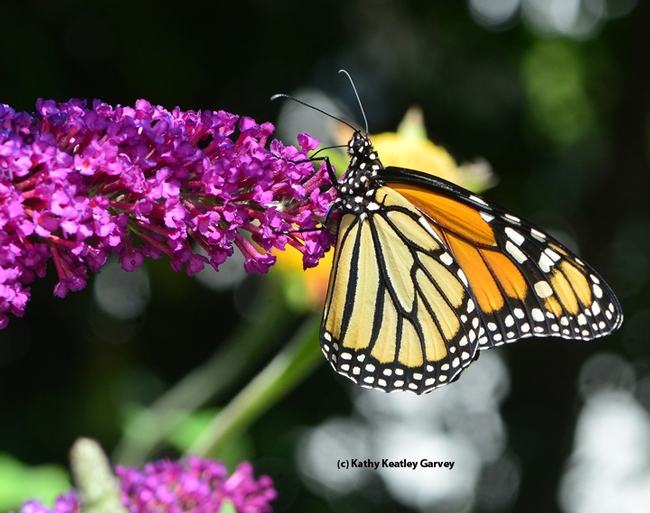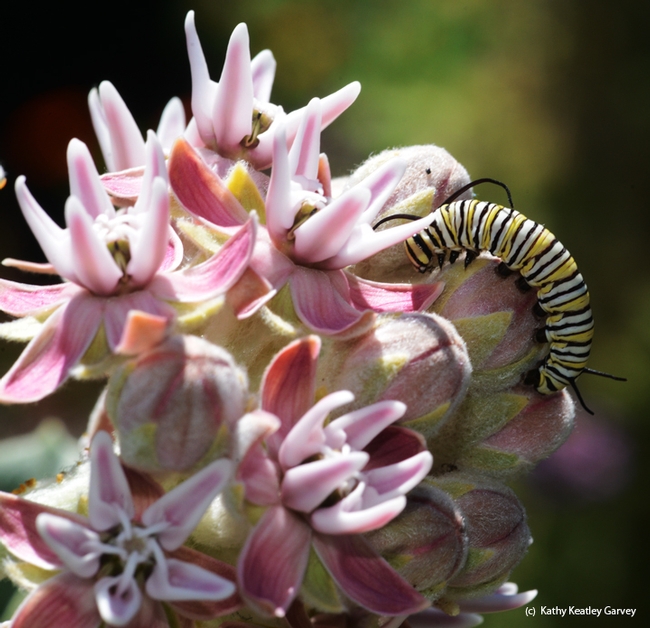- Author: Kathy Keatley Garvey
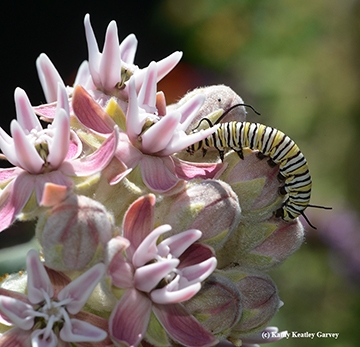
All summer and into fall, we spotted the familiar reddish, black and white bugs scurrying around on our showy milkweed, Asclepias speciosa, and tropical milkweed, Asclepias curassavica.
Showy bugs on showy milkweed.
The ones we saw: the Small Milkweed Bug, Lygaeus kalmii. Like its name implies, it's small, about half an inch long.
They're primarily seed eaters, but they're opportunistic and generalists, says insect migration biologist Hugh Dingle, emeritus professor of the UC Davis Department of Entomology and Nematology, author of the popular textbook, Animal Migration: the Biology of Life on the Move. "They'll get protein from wherever they can find it," he said. Dingle, whose research includes migratory monarchs, said the milkweed bugs not only eat seeds, but they also eat monarch eggs and larvae and the immature stages of other butterflies. Forever the opportunists, they eat other small bugs as well--if the opportunity arises. And they feed on nectar, too.
Some scientists have seen them feeding on insects trapped in the sticky pollen of the showy milkweed.
The bugs, it seem, have few predators. They feed on the toxic milkweed, which makes them distasteful to predators, prey to avoid. Their warning colors (red and black) strike home that fact.
In the fall, as the seed pods burst open, it's a horticulture/culinary war between the milkweed growers and the milkweed bugs. Both want the seeds: the humans to plant them and the bugs to eat them.
(Note: Research shows that the milkweed bug also feeds on other plants. Read about the opportunist Small Milkweed Bug in the Journal of the New York Entomological Society.)
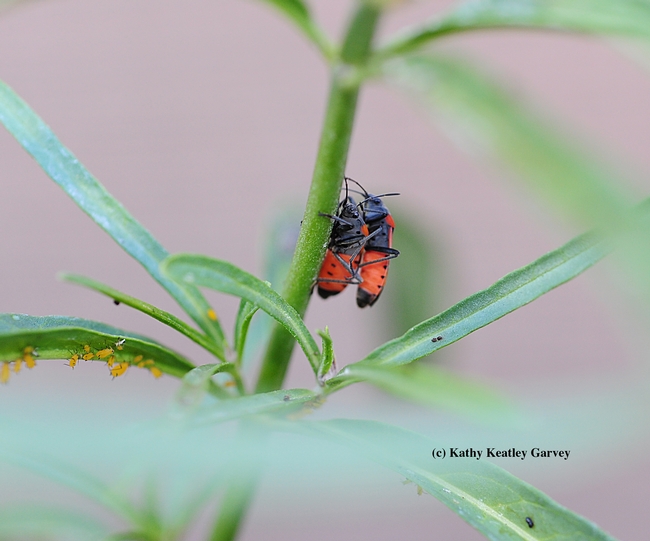
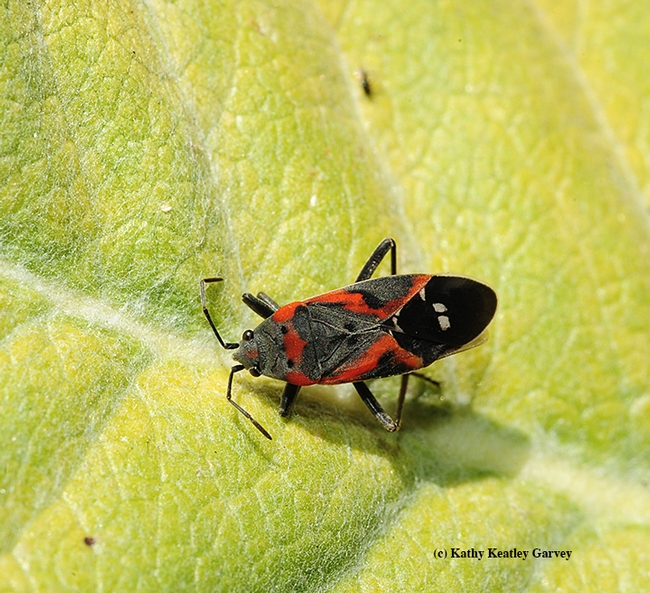
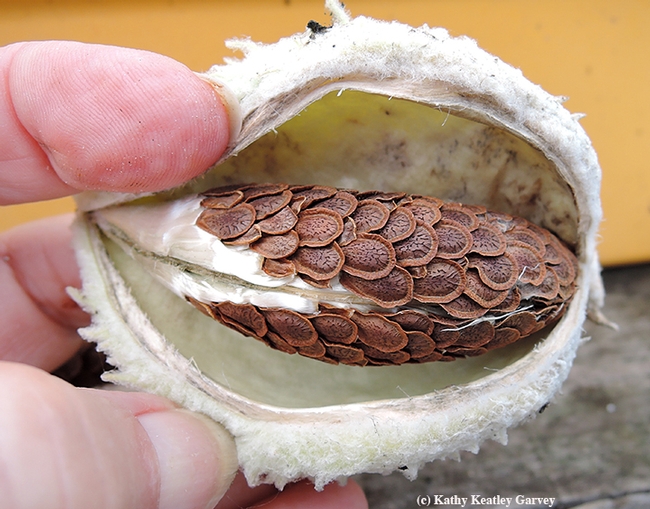
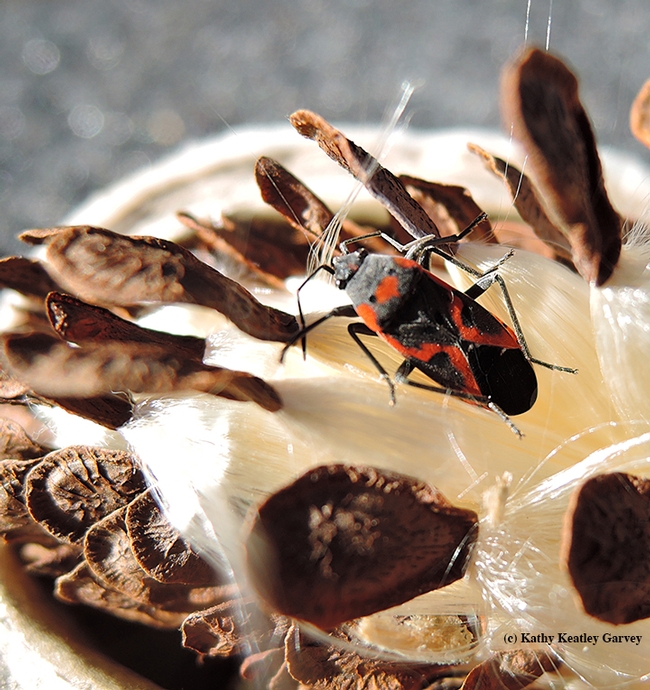
- Author: Kathy Keatley Garvey
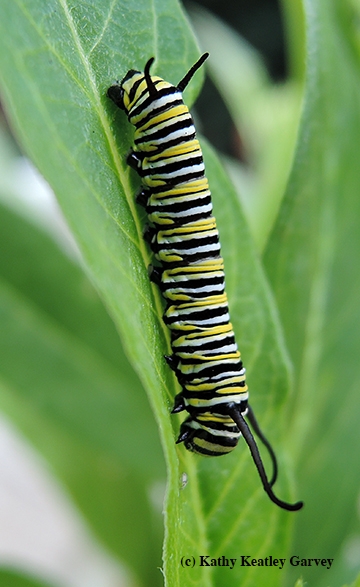
We walked into our little pollinator garden in Vacaville, Calif., this afternoon to cut a few tropical milkweed stems to feed the indoor caterpillars, and there, hidden beneath a leaf, was a tiny caterpillar.
Well, hello, there! Aren't you a little late? The monarchs have been overwintering along coastal California for a couple of months. Your parents did not get the memo.
This uncharacteristic weather we're having--autumn temperatures soaring into the 70s here in recent weeks--means the milkweed is still growing and the caterpillars are, too.
We've pruned all of the tropical milkweed down to the ground except for one plant that's still flowering. We're keeping it. Food is scarce for the honey bees, syrphid flies and other pollinators.
Meanwhile, Tiny Caterpillar is a new addition to our indoor habitat. Ours is just a small-scale conservation project of rearing and releasing monarchs to help boost the declining monarch population. So far this season, our total is 54. That's 54 that may have been eaten by birds or consumed inside-and-out by parasitoids such as the tachinid flies, which lay their eggs inside the caterpillars or chrysalids. Overall, about 2 or 3 percent of the monarchs make it all the way through their life cycle, from egg to caterpillar to chrysalis to adult, scientists estimate.
Here are the basics of how we rear them, but all Monarch Moms and Monarch Dads do it differently.
- Grow milkweed species, the host plant of the monarchs. We have four different species in our pollinator garden:
--Asclepias fascicularis, narrowleafed milkweed
--Asclepias speciosa, broadleaf milkweed
--Asclepias tuberosa, a Midwest favorite
--Asclepias curassavica, tropical milkweed - In addition to milkweed, plant other nectar-producing plants for your monarchs and other pollinators. The monarch favorites, at least in our yard, include Mexican sunflower (Tithonia), an annual that grows here from April through November (in fact it's still blooming), butterfly bush (Buddleia), and Lantana.
- When you see caterpillars on the milkweed, you'll need to protect them from predators, such as birds, tachinid flies and wasps by bringing them indoors. Add water to a heavy, narrow-necked, flat-bottomed bottle (we use Patron tequila bottles, compliments of our friends). Tuck the milkweed stems, with the 'cats still on the stems, in the tequila bottle. Then place the bottle in a meshed, zippered butterfly habitat, such as the ones from the Bohart Museum of Entomology. You can also buy meshed, zippered laundry bags from stores.
- Be sure to keep the milkweed fresh. Mist it lightly, and add new milkweed daily. Clean the frass from the bottom of the habitat.
- Watch caterpillars eat their fill and then pupate. You'll see the jade-green chrysalids, rimmed in gold, hanging from the top of the habitat.
- When the monarchs eclose, wait for their wings to dry before releasing them. We usually release them after four or five hours--if it's not cold or rainy. Food? They usually won't eat for 24 hours. If the weather is inclement and we can't release them right away, we feed them. We dip a cotton ball into a mixture of honey and water, and place it on a tray, along with a fresh flower or a slice of fruit, such as cantaloupe or watermelon. Some folks feed them a sugar and water mixture. Some use sports drinks such as Gatorade. Mona Miller, administrator of the Facebook page, Raising Butterflies and Moths for Conservation, tells how to feed monarchs on her YouTube channel. She uses 2 tablespoons of water (heated) and 1/2 teaspoon of raw organic honey (more amino acids and protein). She cools the mixture and places in a colorful cap lid (yellow, red, orange).
- When it's time to release a monarch, we just unzip the container. Sometimes we gently cradle the monarch, and then open our hands and watch it go. Some monarchs take off immediately. Others linger on our hands or head for a nearby plant.
- After you release each batch of monarchs, clean the container with soapy water and a little bleach.
Some excellent resources to get you started and keep you going:
- Xerces Society: Monarchs for Conservation and Project Milkweed
- The Beautiful Monarch, Facebook page administered by Holli Webb Hearn
- Raising Butterflies and Moths for Conservation, Facebook page administered by Mona Miller
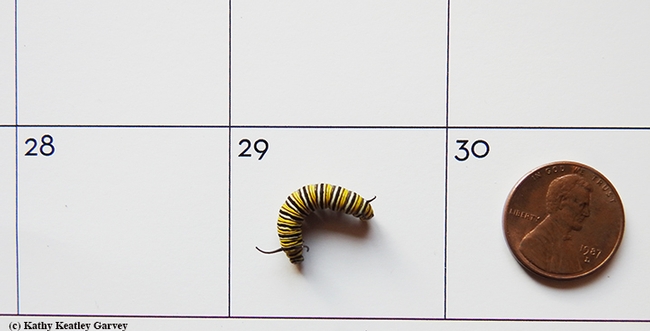

- Author: Kathy Keatley Garvey

Then it happened. The three monarchs caterpillars that we'd been rearing in our indoor butterfly habitat, pupated, forming those familiar, awe-inspiring jade-green chrysalids. Soon three monarchs--two males and a female--eclosed.
Should they go? Or should they stay?
The first monarch, a male, eclosed on Tuesday, Nov. 8, Election Day. What to do? Wait for the other two to eclose and drive them all to Santa Cruz—since we're going there any way on Monday, Nov. 14-- or release him now? Decisions, decisions, decisions.
An inner voice argued with me.
Me: “Release him. Let him be a butterfly.”
Inner Voice: “If we transport him there, he'll have a better chance of survival. It's November and pretty late in the migratory season for him to make that 113-mile journey. He can join the cluster of 800 to 1000 already there, overwintering high and happily in the eucalyptus trees, and then next February, he'll head inland.”
Me: “No. Release him. He's antsy. He wants out. Besides, how do you know if wants to go to Santa Cruz? Maybe that's not on his itinerary!”
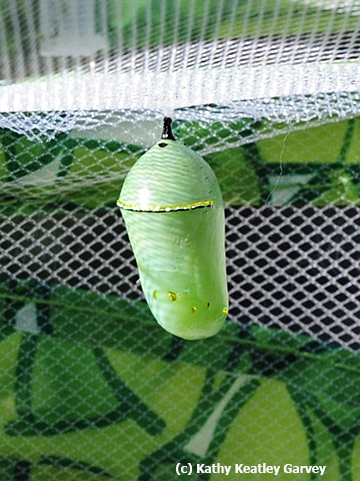
So off went Butterfly No. 1, soaring 80 feet high into the air. He never looked back.
Then a female eclosed on Thursday, Nov. 10 and a male on Friday, Nov. 11, Veterans' Day. The weather report indicated rain within the next few days. Release them or drive them to Santa Cruz?
Me: “Well, since we're going there any way on Nov. 14, and the monarch population is declining, why not take these two to Santa Cruz?”
Inner Voice: “Yes! Why not?”
So off we went, Don, Marilyn, Jim, yours truly and the two monarchs, Danaus plexippus, well fed and roosting comfortably in their mesh butterfly habitat.
We left Fairfield mid-morning on Nov. 14, and after a 90-minute trip, arrived at Natural Bridges around noon. It was a picture-perfect autumn day, a day to treasure, with temperatures at 60 degrees and rising. And, there we were, standing in the monarch sanctuary, in awe of a thousand tiny butterflies silently clustering in the towering eucalyptus trees. From 80 feet below, the drab-graylike clusters looked ever so much like dead leaves. When the clusters broke in the warmth of the sun, the sanctuary took on a life—and color--of its own. The iconic orange, black and white butterflies glided and soared above us in numbers that folks rarely see.
There is strength in numbers. Color, too.
We found a secure place, away from the crowd, to release the Vacaville born-and-reared monarchs. The female went first, fluttering delicately out of Marilyn's hand to join the others. The male lingered several minutes on her finger, and then he, too, departed, soaring high.
Freedom's just another word for nothin' left to lose…
Poet Gertrude Stein once described Oakland as: “There is no there there.”
But in monarch overwintering sites in Santa Cruz, there is. There is a "there" when “they're there.”
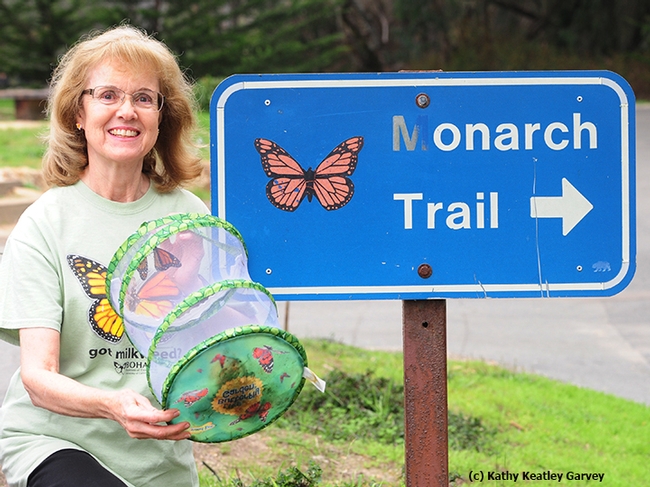
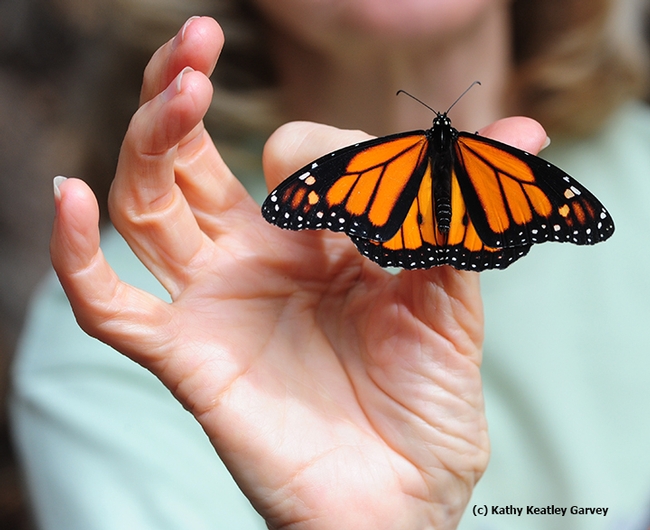
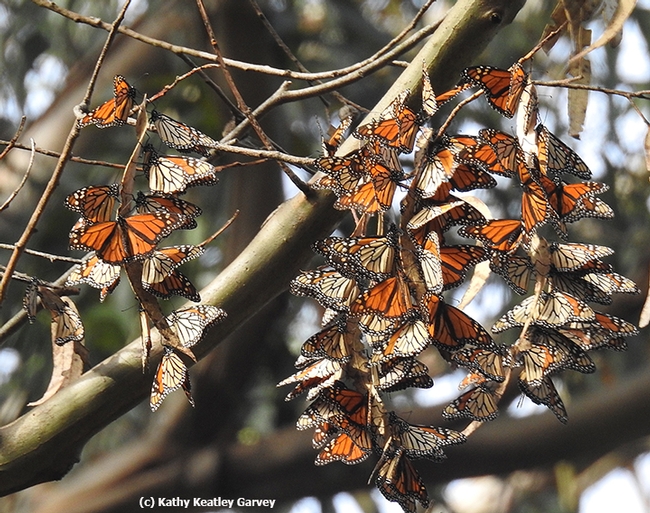
- Author: Kathy Keatley Garvey
What amazing journeys!
For the last two months, migratory monarch butterflies have regularly stopped for flight fuel in our 600-square-foot pollinator garden in Vacaville, Calif. to nectar on Mexican sunflower (Tithonia), butterfly bush (Buddleia) and Lantana.
At any given time--morning and afternoon throughout September and October--we'd see four and five in the garden. A veritable migratory corridor! A veritable visual feast!
Now it's November, and we haven't seen any for a week. They've probably already reached their destination--overwintering sites in the area, including Santa Cruz and Pacific Grove.
On Labor Day, we photographed a tagged one, part of the research project of David James, entomologist at Washington State University. (See Bug Squad blog; WSU News story by Linda Seiford; and a Daily Evergreen piece by reporter Haley Donwerth on the Vacaville find. ABC, Channel 10, Sacramento, also covered "Why does this butterfly have a sticker on it?", interviewing butterfly expert Art Shapiro, UC Davis distinguished professor of evolution and ecology.
It's exciting to read the reports on the Monarchs in the Pacific Northwest Facebook page, as the tagged monarchs are photographed and recorded. Several recent entries:
- Nov. 7: "Two new tag recoveries from California! Both are currently in the Lighthouse Field, Santa Cruz overwintering colony (currently numbering about 7000) and both were found by John Dayton. The tagged Monarch (shown on the page) has flown at least 750 miles from Redmond, WA where it was reared and released on September 20 by Connie Grandberg. This is the first recovery of a Seattle-area Monarch in our program! There are now 4 PNW-tagged Monarchs residing at Lighthouse Field! We will provide information on the second new recovery once we get all the associated details."
- Nov. 7: Our second new tag recovery from Santa Cruz! This one is remarkable in that it is almost obscured from view among the other butterflies. As luck would have it, the only bit of the tag showing for John Dayton's camera is the bit with the serial number! A6935, is a female, and she was reared in Brookings in southern Oregon by Andrea Christensen and released by her at nearby Redwood Bar along the Chetco River on August 25. Santa Cruz will be Ms A6935's winter home and who knows where she will go next spring? Many thanks to Andrea and John for making this recovery possible!"
- Nov. 2: "Today we proudly announce the 9th long distance tagged Monarch recovery of this season so far! A female Monarch tag B2174 was found on November 1 at Morro Bay State Beach by Regena Orr a biologist with CA State Parks. B2174 was among about 350 clustering Monarchs and has travelled an estimated 792 miles since September 8 when it was released in Yakima, Washington! This Monarch was reared by Cindy Dunbar as part of a rearing program between PNW Monarchs and Cowiche Canyon Conservancy. 152 monarchs were reared by the 14 members of this group in 2016 and this is the first recovery for the group Congratulations! This Monarch now holds the record of the longest distance traveled by a Yakima-released Monarch. The photo shows a silhouetted group of Monarchs at Morro Bay in 2015."
Stay tuned. And stay focused with your camera! You might see a tagged one at an overwintering site.
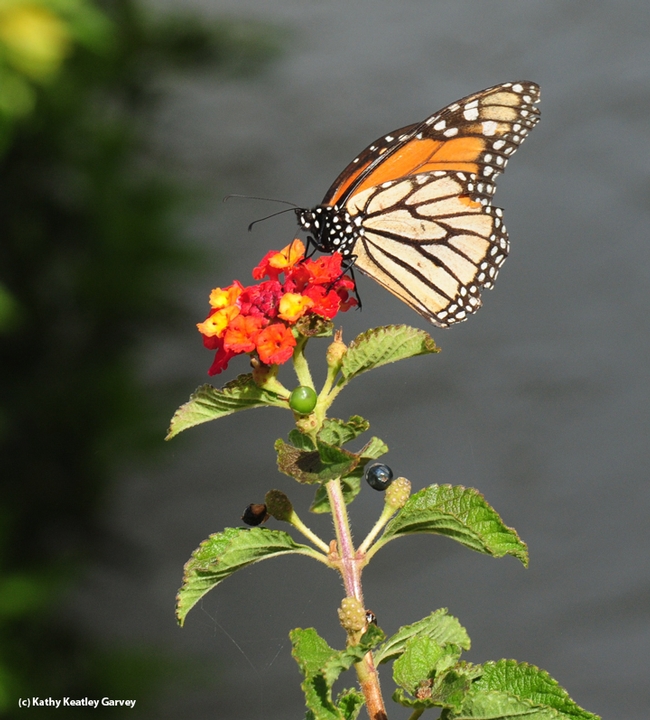
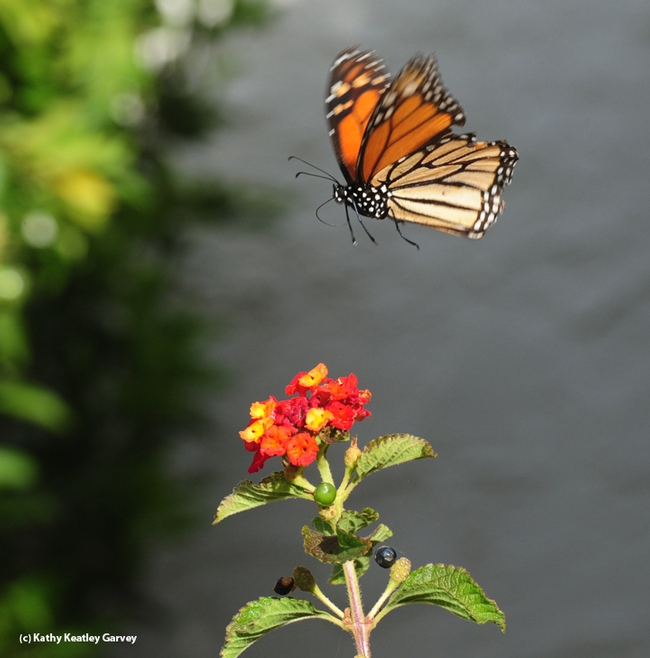
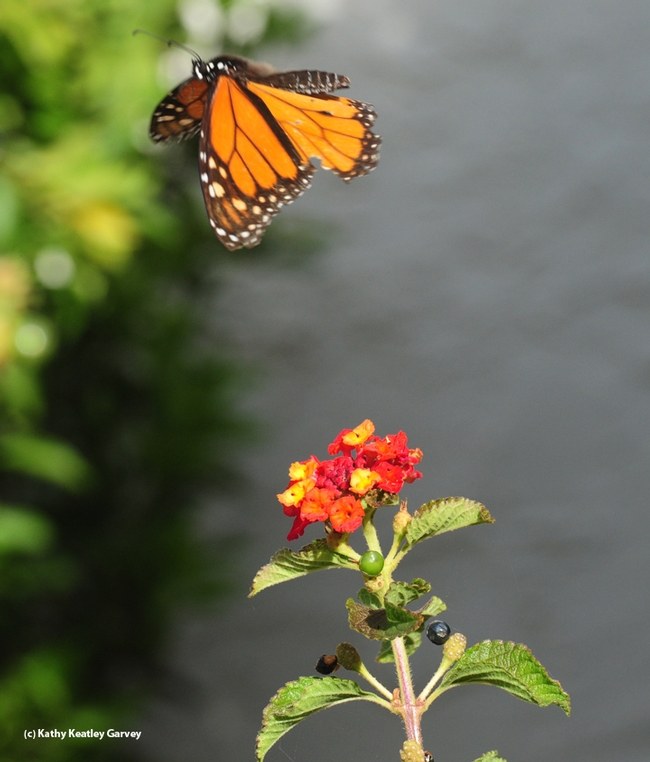
- Author: Kathy Keatley Garvey
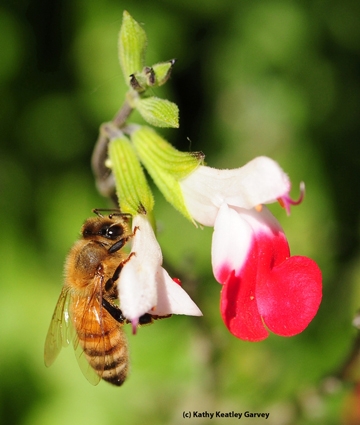
If you're looking for plants to attract pollinators, including bees and butterflies, then the UC Davis Arboretum's Plant Sale on Saturday, Oct. 22 is the place to "bee."
A public fall clearance sale will be held from 9 a.m. to 1 p.m. at the Arboretum Teaching Nursery on Garrod Drive, UC Davis campus. It will feature a "wide selection of Arboretum All-Stars, California natives, and gorgeous drought-tolerant plants," officials said. Members (new members can join at the door) save 10 percent and also reap other benefits.
The sale will include more than 16,500 plants and more than 450 varieties.
Will they have milkweed? Yes.
"It looks like we'll have plenty of milkweed, two varieties--Kotolo (Asclepias eriocarpa) and showy milkweed (Asclepias speciosa)," said Katie Hetrick, director of communications.
Will they have butterfly bush (Buddleia)? Yes.
"We have a ton of Buddleia," said Hetrick, mentioning just a few: Magenta Munchkin, Dark Dynasty, Buzz, Orchid Annie, Purple Haze, Lavender Cupcake--and "The Chips": Lilac Chip, Pink Micro Chip, and Blue Chip Jr.
"And let's not forget all the Salvias!" Hetrick said. "Those are a nectar fave with pollinators including butterflies, bees and hummingbirds!" Among the Salvias on sale: Bee's Bliss, Pacific Blue, Marine Blue, Pozo Blue, Debbie's Rose, Little Kiss, Red Swing, Violet Riot, Royal Bumble, Hot Lips, and Scott's Red.
Taylor Lewis, UC Davis Arboretum and Public Garden Nursery Manager, related that pipevine, the host plant of the pipevine swallowtail butterfly (Battus philenor), will be available.
Ellen Zagory, director of horticulture, listed some of her favorite sunflower family plants that attendees can buy:
- Aster 'Monch'
- Coreopsis, 'Little Penny'
- Coreopsis, 'Enchanted Eve'
- Coreopsis, 'Red Elf'
- Echibeckia, 'Summerina Brown'
- And lots of Echinacea (cone flowers)
For a full list of the plants available, download the PDF.
And, it's interesting to see what folks in the area have planted instead of lawns. The Aboretum's web page offers great ideas.
Do you know how much acres in the United States are planted in lawn? Huffington Post reports in a 2015 news story: "According to a new study from NASA scientists in collaboration with researchers in the Mountain West, there is now an estimated total of 163,812 square kilometers, or more than 63,000 square miles, of lawn in America — about the size of Texas."
All that manicuring, all that water, all that work. And little or no food or shelter for the pollinators.
Every well-manicured lawn "uses up to 900 liters of water per person per day and reduces sequestration effectiveness by up to 35 percent by adding emissions from fertilization and the operation of mowing equipment," Huffington Post says.
Indeed, lawn is our nation's single largest "crop."
But it doesn't have to be. There IS life after lawn. And there is MORE life after lawn.
